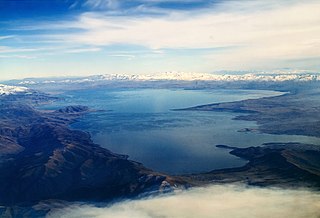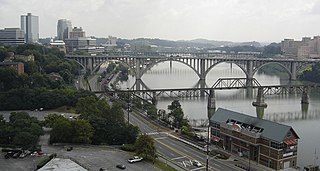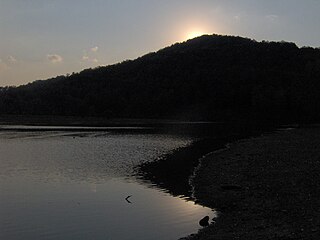




The following is a list of lakes and reservoirs in the state of Kentucky in the United States.

A lake is an area filled with water, localized in a basin, that is surrounded by land, apart from any river or other outlet that serves to feed or drain the lake. Lakes lie on land and are not part of the ocean, and therefore are distinct from lagoons, and are also larger and deeper than ponds, though there are no official or scientific definitions. Lakes can be contrasted with rivers or streams, which are usually flowing. Most lakes are fed and drained by rivers and streams.

A reservoir is, most commonly, an enlarged natural or artificial lake, pond or impoundment created using a dam or lock to store water.

In the United States, a state is a constituent political entity, of which there are currently 50. Bound together in a political union, each state holds governmental jurisdiction over a separate and defined geographic territory and shares its sovereignty with the federal government. Due to this shared sovereignty, Americans are citizens both of the federal republic and of the state in which they reside. State citizenship and residency are flexible, and no government approval is required to move between states, except for persons restricted by certain types of court orders. Four states use the term commonwealth rather than state in their full official names.
- Lake Barkley (extends into Tennessee)
- Barren River Lake
- Beaver Lake
- Boltz Lake
- Buckhorn Lake
- Bullock Pen Lake
- Lake Beshear
- Cannon Creek Lake
- Lake Carnico
- Carr Creek Lake (formerly Carr Fork Lake)
- Cave Run Lake
- Cedar Creek Lake
- Cranks Creek Lake
- Lake Cumberland
- Dale Hollow Lake (extends into Tennessee)
- Dewey Lake
- Doe Run Lake
- Elk Lake
- Elmer Davis Lake
- Fishtrap Lake
- Grayson Lake
- Green River Lake
- Greenbo Lake
- Guist Creek Lake
- Herrington Lake
- Kentucky Lake (extends into Tennessee).
- Kincaid Lake
- Laurel River Lake
- Lake Linville
- Lake Malone
- Martins Fork Lake
- Nolin River Lake
- Paintsville Lake
- Pan Bowl Lake
- Rough River Lake
- Shanty Hollow Lake
- Shelby Lake
- Swan Lake
- Taylorsville Lake
- Wilgreen Lake
- Williamstown Lake
- Willisburg Lake
- Wood Creek Lake
- Yatesville Lake

Lake Barkley, a 58,000-acre (230 km2) reservoir in Livingston County, Lyon County and Trigg County in Kentucky and extending into Stewart County and Houston County in Tennessee, was impounded by the U.S. Army Corps of Engineers in 1966 upon the completion of Barkley Dam. Both the lake and the dam are named for Vice President Alben Barkley, a Kentucky native.

Tennessee is a state located in the southeastern region of the United States. Tennessee is the 36th largest and the 16th most populous of the 50 United States. Tennessee is bordered by Kentucky to the north, Virginia to the northeast, North Carolina to the east, Georgia, Alabama, and Mississippi to the south, Arkansas to the west, and Missouri to the northwest. The Appalachian Mountains dominate the eastern part of the state, and the Mississippi River forms the state's western border. Nashville is the state's capital and largest city, with a 2017 population of 667,560 and a 2017 metro population of 1,903,045. Tennessee's second largest city is Memphis, which had a population of 652,236 in 2017.

Barren River Lake is a 10,100 acres (41 km2), reservoir in Kentucky created by the U.S. Army Corps of Engineers in 1964 by impounding the Barren River. The lake occupies parts of Allen, Barren, and Monroe counties.










